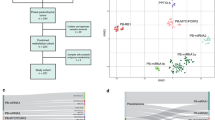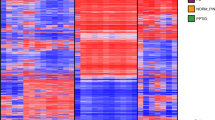Abstract
Tumors of the pineal region comprise several different entities with distinct clinical and histopathological features. Whereas some entities predominantly affect adults, pineoblastoma (PB) constitutes a highly aggressive malignancy of childhood with a poor outcome. PBs mainly arise sporadically, but may also occur in the context of cancer predisposition syndromes including DICER1 and RB1 germline mutation. With this study, we investigate clinico-pathological subgroups of pineal tumors and further characterize their biological features. We performed genome-wide DNA methylation analysis in 195 tumors of the pineal region and 20 normal pineal gland controls. Copy-number profiles were obtained from DNA methylation data; gene panel sequencing was added for 93 tumors and analysis was further complemented by miRNA sequencing for 22 tumor samples. Unsupervised clustering based on DNA methylation profiling separated known subgroups, like pineocytoma, pineal parenchymal tumor of intermediate differentiation, papillary tumor of the pineal region and PB, and further distinct subtypes within these groups, including three subtypes within the core PB subgroup. The novel molecular subgroup Pin-RB includes cases of trilateral retinoblastoma as well as sporadic pineal tumors with RB1 alterations, and displays similarities with retinoblastoma. Distinct clinical associations discriminate the second novel molecular subgroup PB-MYC from other PB cases. Alterations within the miRNA processing pathway (affecting DROSHA, DGCR8 or DICER1) are found in about two thirds of cases in the three core PB subtypes. Methylation profiling revealed biologically distinct groups of pineal tumors with specific clinical and molecular features. Our findings provide a foundation for further clinical as well as molecular and functional characterization of PB and other pineal tumors, including the role of miRNA processing defects in oncogenesis.





Similar content being viewed by others
References
Anglesio MS, Wang Y, Yang W, Senz J, Wan A, Heravi-Moussavi A et al (2013) Cancer-associated somatic DICER1 hotspot mutations cause defective miRNA processing and reverse-strand expression bias to predominantly mature 3p strands through loss of 5p strand cleavage. J Pathol 229:400–409. https://doi.org/10.1002/path.4135
Blanquet V, Turleau C, Gross-Morand MS, Senamaud-Beaufort C, Doz F, Besmond C (1995) Spectrum of germline mutations in the RB1 gene: a study of 232 patients with hereditary and non hereditary retinoblastoma. Hum Mol Genet 4:383–388. https://doi.org/10.1093/hmg/4.3.383
Bohrnsen F, Enders C, Ludwig HC, Bruck W, Fuzesi L, Gutenberg A (2015) Common molecularcytogenetic alterations in tumors originating from the pineal region. Oncol Lett 10(3):1853–1857. https://doi.org/10.3892/ol.2015.3383
Capper D, Jones DTW, Sill M, Hovestadt V, Schrimpf D, Sturm D et al (2018) DNA methylation-based classification of central nervous system tumours. Nature 555:469–474. https://doi.org/10.1038/nature26000
Consortium EP (2012) An integrated encyclopedia of DNA elements in the human genome. Nature 489:57–74. https://doi.org/10.1038/nature11247
de Jong MC, Kors WA, de Graaf P, Castelijns JA, Kivela T, Moll AC (2014) Trilateral retinoblastoma: a systematic review and meta-analysis. Lancet Oncol 15:1157–1167. https://doi.org/10.1016/S1470-2045(14)70336-5
de Jong MC, Kors WA, de Graaf P, Castelijns JA, Moll AC, Kivela T (2015) The incidence of trilateral retinoblastoma: a systematic review and meta-analysis. Am J Ophthalmol 160(1116–1126):e5. https://doi.org/10.1016/j.ajo.2015.09.009
de Kock L, Sabbaghian N, Druker H, Weber E, Hamel N, Miller S et al (2014) Germ-line and somatic DICER1 mutations in pineoblastoma. Acta Neuropathol 128:583–595. https://doi.org/10.1007/s00401-014-1318-7
Dimaras H, Kimani K, Dimba EA, Gronsdahl P, White A, Chan HS et al (2012) Retinoblastoma. Lancet 379:1436–1446. https://doi.org/10.1016/S0140-6736(11)61137-9
Farnia B, Allen PK, Brown PD, Khatua S, Levine NB, Li J et al (2014) Clinical outcomes and patterns of failure in pineoblastoma: a 30-year, single-institution retrospective review. World neurosurg 82:1232–1241. https://doi.org/10.1016/j.wneu.2014.07.010
Foulkes WD, Priest JR, Duchaine TF (2014) DICER1: mutations, microRNAs and mechanisms. Nat Rev Cancer 14:662–672. https://doi.org/10.1038/nrc3802
Frankish A, Diekhans M, Ferreira AM, Johnson R, Jungreis I, Loveland J et al (2019) GENCODE reference annotation for the human and mouse genomes. Nucleic Acids Res 47:D766–D773. https://doi.org/10.1093/nar/gky955
Friedrich C, von Bueren AO, von Hoff K, Gerber NU, Ottensmeier H, Deinlein F et al (2013) Treatment of young children with CNS-primitive neuroectodermal tumors/pineoblastomas in the prospective multicenter trial HIT 2000 using different chemotherapy regimens and radiotherapy. Neuro Oncol 15:224–234. https://doi.org/10.1093/neuonc/nos292
Gadd S, Huff V, Walz AL, Ooms A, Armstrong AE, Gerhard DS et al (2017) A Children's Oncology Group and TARGET initiative exploring the genetic landscape of Wilms tumor. Nat Genet 49:1487–1494. https://doi.org/10.1038/ng.3940
Gerber NU, von Hoff K, Resch A, Ottensmeier H, Kwiecien R, Faldum A et al (2014) Treatment of children with central nervous system primitive neuroectodermal tumors/pinealoblastomas in the prospective multicentric trial HIT 2000 using hyperfractionated radiation therapy followed by maintenance chemotherapy. Int J Radiat Oncol Biol Phys 89:863–871. https://doi.org/10.1016/j.ijrobp.2014.04.017
Goschzik T, Gessi M, Denkhaus D, Pietsch T (2014) PTEN mutations and activation of the PI3K/Akt/mTOR signaling pathway in papillary tumors of the pineal region. J Neuropathol Exp Neurol 73:747–751. https://doi.org/10.1097/NEN.0000000000000093
Gratias S, Schuler A, Hitpass LK, Stephan H, Rieder H, Schneider S et al (2005) Genomic gains on chromosome 1q in retinoblastoma: consequences on gene expression and association with clinical manifestation. Int J Cancer 116:555–563. https://doi.org/10.1002/ijc.21051
Gustmann S, Klein-Hitpass L, Stephan H, Weber S, Bornfeld N, Kaulisch M et al (2011) Loss at chromosome arm 16q in retinoblastoma: confirmation of the association with diffuse vitreous seeding and refinement of the recurrently deleted region. Genes Chromosomes Cancer 50:327–337. https://doi.org/10.1002/gcc.20857
Heim S, Sill M, Jones DT, Vasiljevic A, Jouvet A, Fevre-Montange M et al (2016) Papillary tumor of the pineal region: a distinct molecular entity. Brain Pathol 26:199–205. https://doi.org/10.1111/bpa.12282
Heravi-Moussavi A, Anglesio MS, Cheng SW, Senz J, Yang W, Prentice L et al (2012) Recurrent somatic DICER1 mutations in nonepithelial ovarian cancers. N Engl J Med 366:234–242. https://doi.org/10.1056/NEJMoa1102903
Hwang EI, Kool M, Burger PC, Capper D, Chavez L, Brabetz S et al (2018) Extensive molecular and clinical heterogeneity in patients with histologically diagnosed CNS-PNET treated as a single entity: a report from the Children's Oncology Group Randomized ACNS0332 Trial. J Clin Oncol. https://doi.org/10.1200/JCO.2017.76.4720
Kaatsch P, Grabow D, Spix C (2018) German Childhood Cancer Registry—annual report 2018 (1980–2017). https://www.kinderkrebsregister.de/typo3temp/secure_downloads/22605/0/2df4719687ba2596d4216218a4f4632763b64847/jb2018s.pdf. Accessed 7 Nov 2019
Kline CN, Joseph NM, Grenert JP, van Ziffle J, Talevich E, Onodera C (2017) Targeted next-generation sequencing of pediatric neuro-oncology patients improves diagnosis, identifies pathogenic germline mutations, and directs targeted therapy. Neuro Oncol 19(5):699–709. https://doi.org/10.1093/neuonc/now254
Koelsche C, Mynarek M, Schrimpf D, Bertero L, Serrano J, Sahm F et al (2018) Primary intracranial spindle cell sarcoma with rhabdomyosarcoma-like features share a highly distinct methylation profile and DICER1 mutations. Acta Neuropathol 136:327–337. https://doi.org/10.1007/s00401-018-1871-6
Kozomara A, Griffiths-Jones S (2011) miRBase: integrating microRNA annotation and deep-sequencing data. Nucleic Acids Res 39:D152–157. https://doi.org/10.1093/nar/gkq1027
Lee JC, Mazor T, Lao R, Wan E, Diallo AB, Hill NS et al (2019) Recurrent KBTBD4 small in-frame insertions and absence of DROSHA deletion or DICER1 mutation differentiate pineal parenchymal tumor of intermediate differentiation (PPTID) from pineoblastoma. Acta Neuropathol. https://doi.org/10.1007/s00401-019-01990-5
Li MH, Bouffet E, Hawkins CE, Squire JA, Huang A (2005) Molecular genetics of supratentorial primitive neuroectodermal tumors and pineoblastoma. Neurosurg Focus 19:E3
Lillington DM, Kingston JE, Coen PG, Price E, Hungerford J, Domizio P et al (2003) Comparative genomic hybridization of 49 primary retinoblastoma tumors identifies chromosomal regions associated with histopathology, progression, and patient outcome. Genes Chromosomes Cancer 36:121–128. https://doi.org/10.1002/gcc.10149
Lohmann DR (1999) RB1 gene mutations in retinoblastoma. Hum Mutat 14:283–288. https://doi.org/10.1002/(SICI)1098-1004(199910)14:4%3c283:AID-HUMU2%3e3.0.CO;2-J
Louis DN, Ohgaki H, Wiestler OD, Cavenee WK (eds) (2016) WHO classification of tumour of the central nervous system, 4th edn. IARC, Lyon
Miller S, Rogers HA, Lyon P, Rand V, Adamowicz-Brice M, Clifford SC et al (2011) Genome-wide molecular characterization of central nervous system primitive neuroectodermal tumor and pineoblastoma. Neuro Oncol 13:866–879. https://doi.org/10.1093/neuonc/nor070
Mynarek M, Pizer B, Dufour C, van Vuurden D, Garami M, Massimino M et al (2017) Evaluation of age-dependent treatment strategies for children and young adults with pineoblastoma: analysis of pooled European Society for Paediatric Oncology (SIOP-E) and US Head Start data. Neuro Oncol 19:576–585. https://doi.org/10.1093/neuonc/now234
Northcott PA, Buchhalter I, Morrissy AS, Hovestadt V, Weischenfeldt J, Ehrenberger T et al (2017) The whole-genome landscape of medulloblastoma subtypes. Nature 547:311–317. https://doi.org/10.1038/nature22973
Northcott PA, Shih DJ, Peacock J, Garzia L, Morrissy AS, Zichner T et al (2012) Subgroup-specific structural variation across 1,000 medulloblastoma genomes. Nature 488:49–56. https://doi.org/10.1038/nature11327
Ostrom QT, Gittleman H, Truitt G, Boscia A, Kruchko C, Barnholtz-Sloan JS (2018) CBTRUS statistical report: primary brain and other central nervous system tumors diagnosed in the United States in 2011–2015. Neuro Oncol 20:iv1–iv86. https://doi.org/10.1093/neuonc/noy131
Parikh KA, Venable GT, Orr BA, Choudhri AF, Boop FA, Gajjar AJ et al (2017) Pineoblastoma—the experience at St Jude Children's Research Hospital. Neurosurgery 81:120–128. https://doi.org/10.1093/neuros/nyx005
Rupaimoole R, Slack FJ (2017) MicroRNA therapeutics: towards a new era for the management of cancer and other diseases. Nat Rev Drug Discov 16:203–222. https://doi.org/10.1038/nrd.2016.246
Sahm F, Schrimpf D, Jones DT, Meyer J, Kratz A, Reuss D et al (2016) Next-generation sequencing in routine brain tumor diagnostics enables an integrated diagnosis and identifies actionable targets. Acta Neuropathol 131:903–910. https://doi.org/10.1007/s00401-015-1519-8
Schild SE, Scheithauer BW, Schomberg PJ, Hook CC, Kelly PJ, Frick L et al (1993) Pineal parenchymal tumors. Clinical, pathologic, and therapeutic aspects. Cancer 72:870–880
Schultz KA, Yang J, Doros L, Williams GM, Harris A, Stewart DR et al (2014) DICER1-pleuropulmonary blastoma familial tumor predisposition syndrome: a unique constellation of neoplastic conditions. Pathol Case Rev 19:90–100. https://doi.org/10.1097/PCR.0000000000000027
Schultz KAP, Rednam SP, Kamihara J, Doros L, Achatz MI, Wasserman JD et al (2017) PTEN, DICER1, FH, and their associated tumor susceptibility syndromes: clinical features, genetics, and surveillance recommendations in childhood. Clin Cancer Res 23(12):e76–e82. https://doi.org/10.1158/1078-0432.CCR-17-0629
Shukla GC, Singh J, Barik S (2011) MicroRNAs: processing, maturation, target recognition and regulatory functions. Mol Cell Pharmacol 3:83–92
Snuderl M, Kannan K, Pfaff E, Wang S, Stafford JM, Serrano J et al (2018) Recurrent homozygous deletion of DROSHA and microduplication of PDE4DIP in pineoblastoma. Nat Commun 9:2868. https://doi.org/10.1038/s41467-018-05029-3
Sturm D, Orr BA, Toprak UH, Hovestadt V, Jones DTW, Capper D et al (2016) New brain tumor entities emerge from molecular classification of CNS-PNETs. Cell 164:1060–1072. https://doi.org/10.1016/j.cell.2016.01.015
von Bueren AO, Gerss J, Hagel C, Cai H, Remke M, Hasselblatt M (2012) DNA copy number alterations in central primitive neuroectodermal tumors and tumors of the pineal region: an international individual patient data meta-analysis. J Neurooncol 109(2):415–423. https://doi.org/10.1007/s11060-012-0911-7
Wegert J, Ishaque N, Vardapour R, Georg C, Gu Z, Bieg M et al (2015) Mutations in the SIX1/2 pathway and the DROSHA/DGCR8 miRNA microprocessor complex underlie high-risk blastemal type Wilms tumors. Cancer Cell 27:298–311. https://doi.org/10.1016/j.ccell.2015.01.002
Worst BC, van Tilburg CM, Balasubramanian GP, Fiesel P, Witt R, Freitag A et al (2016) Next-generation personalised medicine for high-risk paediatric cancer patients—the INFORM pilot study. Eur J Cancer 65:91–101. https://doi.org/10.1016/j.ejca.2016.06.009
Yamanaka R, Hayano A, Takashima Y (2017) Trilateral retinoblastoma: a systematic review of 211 cases. Neurosurg Rev 42:39–48. https://doi.org/10.1007/s10143-017-0890-4
Acknowledgements
This research was funded in part through the NIH/NCI Cancer Center Support Grant P30 CA008748 to Memorial Sloan Kettering Cancer Center (to Matthias A. Karajannis). Christian Thomas has been supported by Innovative Medizinische Forschung Münster (IMF TH 111807). Grants from the Friedberg Charitable Foundation, the Sohn Conference Foundation and the Making Headway Foundation were provided to Matija Snuderl.
Author information
Authors and Affiliations
Corresponding author
Additional information
Publisher's Note
Springer Nature remains neutral with regard to jurisdictional claims in published maps and institutional affiliations.
Electronic supplementary material
Below is the link to the electronic supplementary material.
401_2019_2101_MOESM1_ESM.tif
Supplementary figure 1: Comparing 3’/5’miRNA expression across samples, the expression of 5’ miRNA was on average slightly higher (each column pair represents one case) (a). The PB subtypes displayed a lower fraction of completely processed miRNA in relation to all miRNA (miRNA: #Mature/(#Hairpin + #Mature)) (b). Detailed small RNA composition for the individual subtypes (c). (TIF 97463 kb)
Rights and permissions
About this article
Cite this article
Pfaff, E., Aichmüller, C., Sill, M. et al. Molecular subgrouping of primary pineal parenchymal tumors reveals distinct subtypes correlated with clinical parameters and genetic alterations. Acta Neuropathol 139, 243–257 (2020). https://doi.org/10.1007/s00401-019-02101-0
Received:
Revised:
Accepted:
Published:
Issue Date:
DOI: https://doi.org/10.1007/s00401-019-02101-0




